Heliostats are the component with the greatest impact on the cost in solar tower CSP installations, assuming 50% of the total investment. In the last years, there have been serious attempts to reduce cost by relaxing some features. The TITAN TRACKER concept achieves the goal of reducing cost offering higher performance than the rest of heliostats.
Low-cost and high performance heliostats
Juan Pablo Cabanillas, Carlos García | Titan Tracker
The main conclusion of the comprehensive report of Sandia National Laboratories “Heliostat Cost Reduction Study” published in June 2007 is that the feasibility of the solar tower thermoelectric power plant goes through get reliable and efficient heliostats at a cost much lower than the different known solutions.
The working group which took part this study, about 30 international experts, pointed out 100 $/m rate (base 2006) as target cost for heliostats at a long term defining a series of R&D projects to achieve it, among others, increasing the size, mega heliostats, reducing the cost of the drive or apply carousel designs.
Later, TITAN TRACKER presented its innovative technology, which allows the complete fulfillment of all these targets for the heliostats, both economical and technical, to facilitate commercial deployment of the CSP central receiver technology.
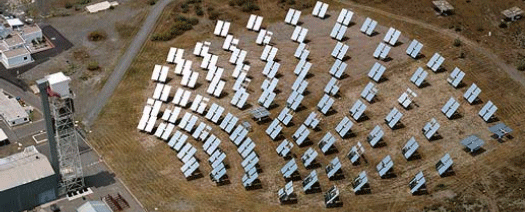
Heliostat field in PSA www.psa.es
History and state-of-the art
As we deal with heliostats for CSP tower plants, we are talking about two-axis solar tracking systems and obviously the tracking accuracy. The solutions better known up- to-date are many and varied types, which demonstrates that determining the right solution is not a trivial matter.
The largest group among the heliostats is characterized by "a single central support", with single pole (pole mounted) and also without pole.
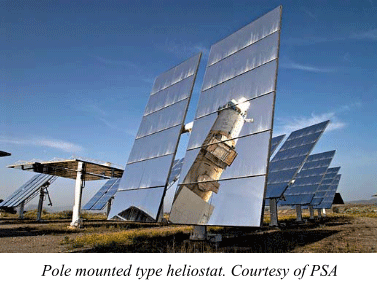
Another important family is the “carousel” type heliostats characterized in that the azimuth rotation is achieved by rolling on a track, usually made of concrete and, in some cases, of metal grid. In this family of carousel trackers, it should be distinguished a subtype as "rotating table or lentil”; this subtype is characterized in that the mirrors are arranged in different parallel planes.
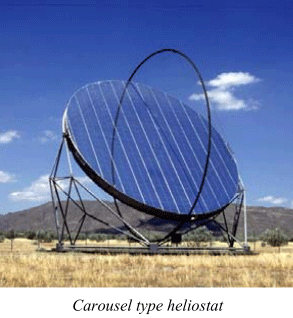
Out of these families, there are other different solutions, but sorting these solutions is really difficult because the characteristics of each are both unique and common to other solutions, this makes their classification not easy and not provide significant advantages.
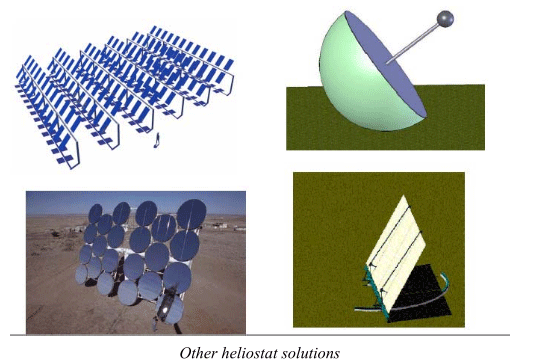
Technical evaluation
Consequence of the first concept, each of the types of heliostats meets technical specifications that facilitate or hinder the implementation of the functional requirements, and consequently, the target costs.
“SINGLE CENTRAL SUPPORT” HELIOSTATS:
• Since these heliostats have a single central support, are more sensitive to wind loads (less rigid) and their deformations are really high, losing the functionality because high deformations even under low winds, inducing less energy yield.
• The junction between the wing and the ground always passes through the drive. Drive is subjected to high and pulsating loads that determine its durability by making it work as a structural component. In many cases, it is very difficult to repair or replace.
• Low accuracy because of their driving from the center and, consequently, suffer the following problems:
Reduced lever action -> discontinuous movement -> Slacks -> Hysteresis
• They suffer high stress because large number of start-stop cycles (more numerous for greater accuracy desired)
• Drive with nonstandard “ad hoc” design components, which affects high price (one of the elements identified in the study as a precursor of the high price of the heliostats of one central support)
“CAROUSEL” HELIOSTATS:
The carousel concept avoids most of the drawbacks of the previous family of "one central support"
• They have several points of support, therefore, are more stable and rigid.
• The driving system is not a part of the structure.
• The lever arm is longer because movement is not done from the center it may be more accurate and can track continuous without stops, less stress, etc ...
• The motor gears may be standard components.
In the type of "rotating table or lentil" the biggest drawback is that it also carries the shadow area and, therefore, is carrying a useless area or zone with a corresponding impact on cost, hampering competition in costs with other carousel solutions. The implementation of the track, in some cases may involve a high cost, especially in those types that require high quality grading for the proper functioning of the heliostat.
Other heliostats types:
Outside these two main families we do not know any system or relevant concept that deserves to be analyzed in detail.
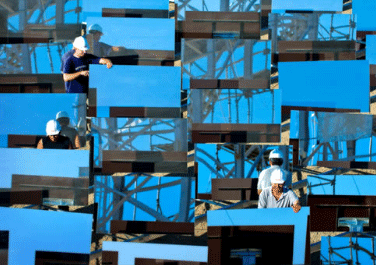
TITAN TRACKER heliostat concept
The Titan Tracker heliostat is an enhanced carousel type by having part of the support structure located in front of the mirrors or panels; this structure is its "nose" feature. The geometry of the tracker allows the establishment of the "nose" without shadow.
It is a proven technology that confirms in use their theoretical advantages. Since its launching in the market, this concept has been used in flat PV, having hundreds of Titan Trackers running some years ago without any problem. Therefore, Titan Tracker is not only an idea but a real proven technology working which demonstrates all its advantages.
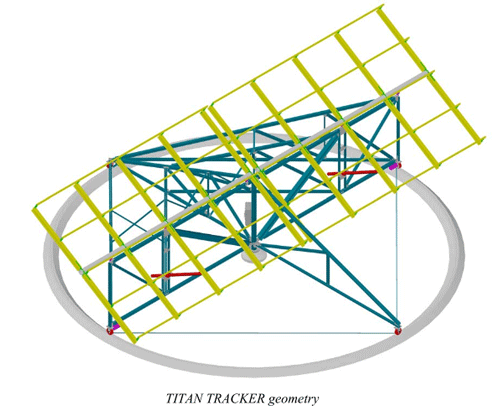
The benefits derived of this new geometry are, among others:
• Support: There are five supports: a central support and four rolling outside. The five supports and their location give a great stability.
• Structure: Its geometry allows manufacture by 3D beams, which provides great rigidity compatible with a great economy of steel.
These two features imply that deformations are low even under high winds, maintaining the functionality with medium and high winds, and allowing their calculation and design for wind loads much higher than usually considered.
• Foundation: It takes only 65% of concrete and 20% of steel necessary in a mounted pole with similar mirror surface. The track does not require high quality grading, admitting irregularities of ± 10 mm. in the 220 m2 models This provides an extremely economic foundation.
• Drive: The drive and structure are completely independent. The azimuth drive is located in the outer sides, allowing the tracking of the sun with a continuous movement of very high precision (without frequent starts and stops). Their geometry can work with one drive in azimuth about 50 times greater than a central support tracker of the same size (equivalent to 50 times more accurate and 50 times less power need for the same motor) The drive components are standard (low price).
• Accuracy: The intrinsic accuracy "closed-loop control-drive-structure" obtained is very high, about 0.01° and, therefore, an order of magnitude 10 times better than the one central support trackers known. Note that if the pointing accuracy is increased about 10 times, receiving surface can be reduced about 100 times. Please fin below a track record of the extreme accuracy of the model 125-219 PRECISION model first prototype for CPV installed in the ISFOC facilities dated August 1st 2009.
.gif)
• Energy yield: The accuracy of this technology is a synonymous of higher performance and, therefore, more profitabiliy.
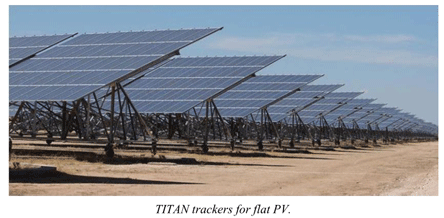
Comparative analysis: performance
The technical requirements in the previously referenced study carried out by SANDIA labs for the second generation heliostats are detailed in the table below; also are attached the features that TITAN TRACKER offer.
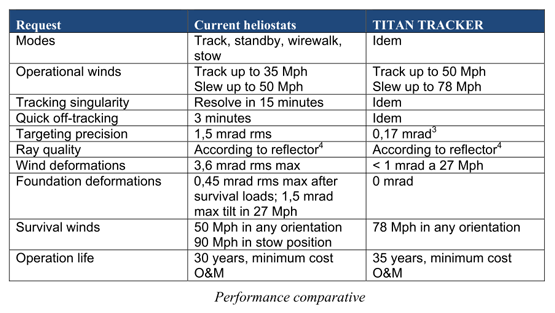
We understand that these benefits objective established for current heliostats can be treated very undemanding. We imagine that the problem is that if demand increases, also increases the index "cost/m2" of the heliostat, and therefore there would be a disservice to the target cost rather than economic approach. In fact, one of the proposals of SANDIA report was to reduce further the performance to lower the drive in mounted pole design.
We analyze the two most important technical requirements in the heliostats: design loads and pointing accuracy.
• Design loads. The requirements for survival of 50 Mph in any direction and 90 Mph in stow position (horizontal) are much lower than those that should be established as safe or minimum for a long life outdoors. In the case of TITAN TRACKER is designed to withstand wind load of 78 Mph (125 km/h) in working positions with 100% imbalance. The dynamic pressure of a wind of 78 Mph is 2.43 times higher than the proposed 50 mph wind.
• Pointing accuracy. The accumulated limit error for the pointing accuracy set is clearly improved (set as 3,93 mrad or sqrt ∑ ε2 ). In the case of TITAN TRACKER this accumulated error in the pointing accuracy under wind conditions of 27 Mph is 1,01 mrad, and hence four times better than the 3,93 mrad target. Regardless of any economic assessment, to consider equipment as valid, the first thing is to meet the needs of functionality to the desired working life. We understand that the technical requirements set by the current standard are little demanding. Despite the above, TITAN TRACKER offers much better benefits than those set as a goal.
Comparative analysis: cost
SANDIA report makes the study of the cost in the heliostats, and the estimation of their evolution based on the effect of economies of scale (manufacturing large volumes) and the learning effect for two different designs: glass-metal (ATS) and stretched membrane (SM) both models of the family of "one central support" In the comparative analysis we have focused on the first (ATS), being the most common in the industry.
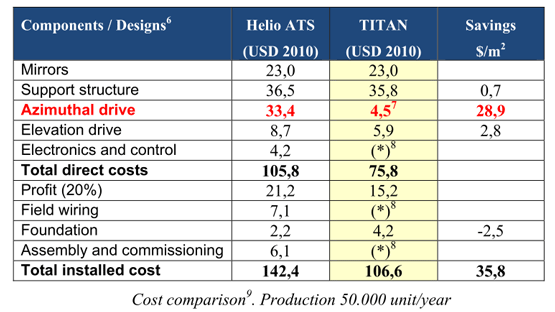
Considering a low level of performance we have discussed and the manufacturing of the amount about 7.5 million m2 (50,000 pcs. Heliostats of 150 m2) in 2006 and in dollars of that year, the report estimates that the cost would be at about 126 $/m2 (equivalent to 142.4 $/m2 of 2010) also believes that maintaining this rate of production of 7.5 million m2 per year, the effects of learning and volume manufacturing that lead to achieving the target of 100 $/m2 (112 $/m2 of 2010) in 2015.
In the case of TITAN TRACKER we currently have for those 7.5 million m2 (3,400 units of the standard model 125-211 PRECISION) a manufacturing price of 106 $/m2 which represents a radical improvement on the 142.4 $/m2 (2010) given by SANDIA, as well as achieving and even exceeding the target of 112.4 $/m2 (2010) given. TITAN TRACKER also improves performance, and if we choose to reduce benefits with the SANDIA standard analyzed would be added an improvement, further reducing the cost index.
Also is remarkable the influence due to the current euro-dollar exchange at 1.3652 USD/EUR (in 2006 the rate was 1.2 USD/EUR and the strong euro hurts TITAN TRACKER in the comparative for being a European company and all its current data to be in euros)
The table above highlights that some components such as azimuth drive reduces its cost in TITAN TRACKER in an order of magnitude of about 8 times (33.4 $/m2 to 4.5 $/m2 )
Regarding the structure shows a similar cost, but we should mention the influence of the wind load design (50 Mph <<78 Mph) in the calculations. TITAN TRACKER uses simple components that enable large scale manufacture as recommended by the SANDIA report.
The geometry of TITAN TRACKER can be easily increased in size (megaheliostats) due to the intrinsic characteristics that have been mentioned above. Furthermore, this effect size has additional benefits in cabling costs, as well as maintenance. The increased size is not possible as a cost reduction strategy in the heliostats of one central support.
In the case of TITAN TRACKER cost of the foundation is only about 5% of the total due to a patented mechanism that resolves this difficulty in some carousel designs. We consider little realistic the reported ratio of 2,2 $/m2 in case of the mounted pole heliostat.
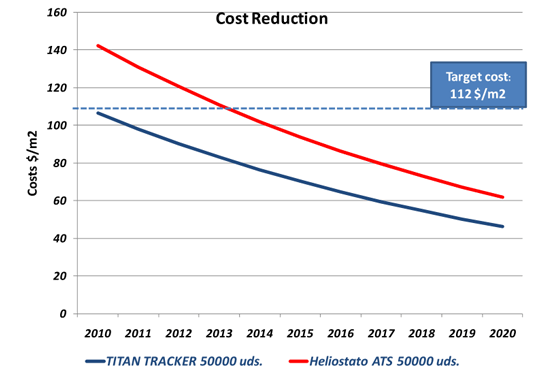
Conclusions
We understand that it should not be trusted any cost reductions to the economies of scale, requirement for minimum benefits or learning effect. It is necessary to take all commercially available technologies that help reduce time-to-market for the commercial deployment of central tower type power plants.
The study published in 2007 by the SANDIA Labs pointed out as a possible solution to reduce cost the development of large carousel heliostat, and in them, seek to reduce the cost of the foundation.
This is what TITAN TRACKER patented in late 2006 and working so far, demonstrating its advantages, managing to get a drastic reduction in costs with significantly improved the technical performance of the heliostats.
References
Heliostat Cost Reduction Study Gregory J. Kolb, Scott A. Jones, Matthew W. Donnelly, David Gorman, Robert Thomas, Roger Davenport, and Ron Lumia
http://prod.sandia.gov/techlib/access-control.cgi/2007/073293.pdf
Sargent & Lundy, Assesment of Parabolic Trough and Power Tower Solar Technology Cost and Performance Forecast, SL-5641, May 2003
http://www.nrel.gov/docs/fy04osti/34440.pdf
About the authors
 Juan Pablo Cabanillas is founder and Managing Director of TITAN TRACKER, a Spanish firm specialized in dual‐axis solar trackers for flat‐ plate and concentrating photovoltaics (CPV) recently developing prototypes for CSP tower and Stirling dish. He has consolidated a solid background in mechanical engineering
Juan Pablo Cabanillas is founder and Managing Director of TITAN TRACKER, a Spanish firm specialized in dual‐axis solar trackers for flat‐ plate and concentrating photovoltaics (CPV) recently developing prototypes for CSP tower and Stirling dish. He has consolidated a solid background in mechanical engineering  during the last 30 years. He has also held several positions in Gibs&Hill and Empresarios Agrupados. He was graduated with a degree in Mechanical Engineering ICAI from University of Comillas, Spain.
during the last 30 years. He has also held several positions in Gibs&Hill and Empresarios Agrupados. He was graduated with a degree in Mechanical Engineering ICAI from University of Comillas, Spain.
Carlos García is Manager of Sales & Marketing of TITAN TRACKER since the year 2008. He has also consolidated a solid background in his previous stage in an international consulting firm specialized in business strategy and product innovation during almost 10 years. He was graduated with a degree in Electronic Engineering ICAI from University of Comillas and Executive MBA by the IE Business School in Madrid, Spain.
The content & opinions in this article are the author’s and do not necessarily represent the views of AltEnergyMag
Comments (0)
This post does not have any comments. Be the first to leave a comment below.
Featured Product

